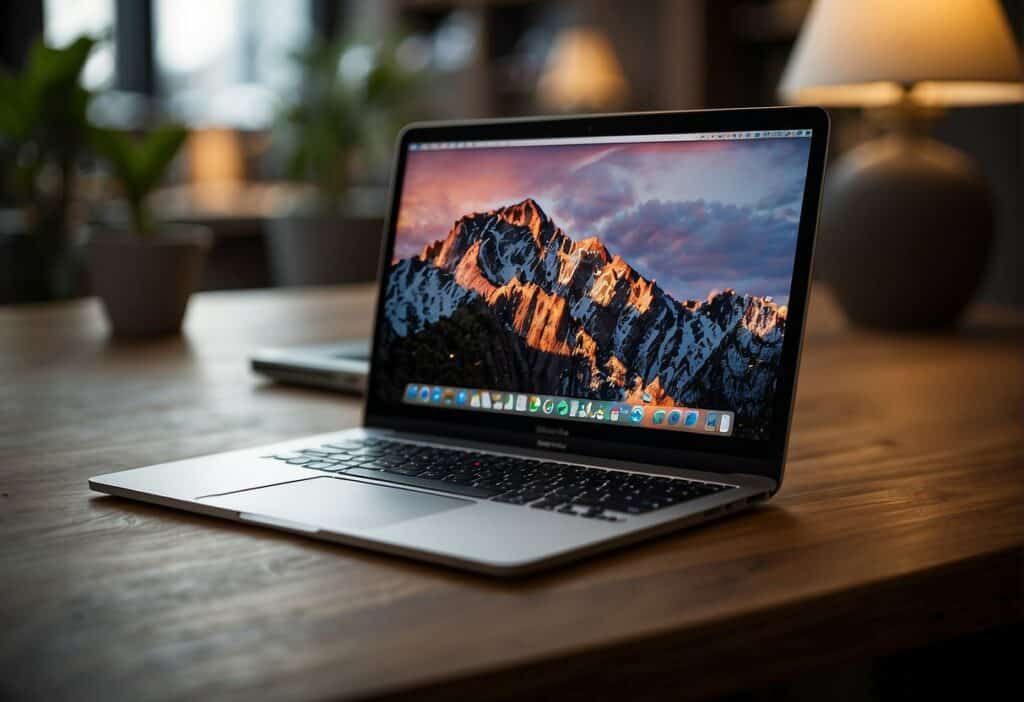Personalizing Your MacBook Air: Tips for a Unique Touch
Make your MacBook Air uniquely yours. Here’s how to personalize it to reflect your style and preferences.

Getting Started with Your MacBook Air
When we first unbox our MacBook Air, the anticipation of its sleek design and the latest macOS is palpable. With our experience in technology journalism, we understand the importance of a seamless setup. Here’s a quick guide to get us started:
- Plug in the MacBook Air to charge while setting it up.
- Power on by pressing the Touch ID button—it also acts as the power button.
- Follow the Setup Assistant to select our language, region, and accessibility options.
- Connect to Wi-Fi to ensure we can download the latest software updates.
- Sign in with our Apple ID or create a new one if this is our first Apple device.
Setting Preferences:
| Preferences | Steps to Customize |
|---|---|
| System Language | System Preferences > Language & Region |
| Wi-Fi | Click Wi-Fi icon > Select network > Enter password |
| Apple ID | Sign in during initial setup or via System Preferences |
Personal Anecdote: The first time we set up our MacBook Air, we customize the trackpad’s gestures—it significantly improved our workflow!
After we’ve completed these steps, personalizing our MacBook Air is next. We can choose a desktop wallpaper, set up Apple Pay, and decide on our notification preferences. If we ever need guidance, the MacBook Air Essentials guide from Apple Support is an excellent resource.
Taking a few minutes to go through these initial steps ensures our MacBook Air is tailored to our liking, making our experience with this powerful machine all the more enjoyable.
Customizing the Desktop and Dock

When we first set up our MacBook Air, one of the joys is making it feel like ours. Adjusting the visuals and interface provides comfort and improves our workflow. Let’s explore the ways to make the Desktop and Dock truly our own.
Changing the Wallpaper
Wallpaper is the first thing most of us change when personalizing our MacBook Air. To do this, navigate to Apple menu > System Settings > Desktop & Screen Saver. We can choose from dynamic wallpapers that change throughout the day, still images, or our personal photos. A personal favorite of ours is setting a family photo that reminds us to take breaks and cherish small moments — a lovely escape during a busy workday.
Adjusting the Dock Position and Size
The Dock is central to our interaction with a Mac, and tweaking it to our liking is key. We can adjust its position — to the bottom, left, or right of the screen — and its size by going to Apple menu > System Settings > Dock & Menu Bar. Here’s a quick reference:
| Setting | Action |
|---|---|
| Position on screen | Bottom, Left, Right |
| Size | Drag the slider to adjust |
| Magnification | Enable and adjust if desired |
Pro tip: I often enlarge the Dock a tad when I’m using my MacBook Air without an external monitor, as it makes interacting with apps easier when I’m on the go.
Organizing Desktop Icons
A cluttered desktop can be overwhelming, but luckily, we can easily tidy up. Simply right-click (or Ctrl-click) on the desktop and select ‘Sort By’ to organize icons by name, kind, date added, or other criteria. We can also drag and drop to manually arrange items, which is perfect for prioritizing our current projects. I always arrange my ongoing projects on the top right side for quick access.
Trackpad and Mouse Settings

Customizing the trackpad and mouse settings on our MacBook Air can significantly enhance our computing experience, providing a fluid and intuitive interaction with our Mac.
Modifying Trackpad Gestures
To optimize our efficiency and comfort, we can tailor the trackpad gestures to fit our personal preferences. Apple’s built-in Trackpad settings offer a variety of options, such as changing the direction of scrolling, enabling or disabling Smart Zoom, and even adjusting the swipe between pages.
One day, we accidentally discovered the three-finger drag, and it completely changed the way we work with text!
Here’s how to start customizing:
- Click on Apple menu > System Settings.
- Select Trackpad to open the gesture customization menu.
We can learn more about each gesture and even preview them in action through the instructional videos provided.
Adjusting Mouse Speed and Direction
The speed at which our mouse responds to our movements can be crucial in our daily tasks — nobody has time for a sluggish cursor! Likewise, knowing how to reverse the scrolling direction to match our personal workflow can be a small change that feels surprisingly natural.
To adjust these settings:
- Navigate to System Settings and choose Mouse.
- Here, we can control the tracking speed and swap the scrolling direction.
| Mouse Settings | Options |
|---|---|
| Tracking Speed | Slow ————– Fast |
| Scrolling | Natural or Standard (reversed) |
Our tidbit of advice: Start with a medium tracking speed and adjust incrementally to find our sweet spot. It took us a few tries, but once we nailed it, our workflow improved in leaps and bounds.
System Preferences Overview
Inexorably tied to personalizing your MacBook Air are the System Preferences, a cornerstone of macOS that allows us to tailor our laptops to our needs. Here, we take charge of various settings that make our MacBook Air truly ours.
Setting Up Internet Accounts
The Internet Accounts section is where we connect our social media, email, and cloud services. Here’s how we do it:
- Open System Preferences and click on Internet Accounts.
- Click the “+” button to add a new account.
- Select the type of account you want to add and enter your login details.
Once I connected my iCloud, my work documents were in perfect harmony across all my devices, making it a breeze to switch from my iPad to my MacBook without skipping a beat.
Configuring Notifications & Do Not Disturb
Notifications can be a double-edged sword; they keep us informed but can be distracting. Here’s how we get the balance right:
- Open System Preferences and select Notifications.
- Choose an app from the list to customize its notification settings.
- Tick Do Not Disturb to enable quiet hours. You can set it to turn on automatically at certain times, when the display is sleeping, or when mirroring to TVs and projectors.
Managing Displays and Monitors
Whether it’s for editing photos or enjoying movies, managing our displays and monitors enhances the visual experience. Let’s look at personalizing these settings:
| Action | Path in System Preferences |
|---|---|
| Adjust resolution | Displays > Display |
| Calibrate colors | Displays > Color |
| Arrange monitors | Displays > Arrangement |
We had our external monitor connected for a dual-screen setup, and with a few tweaks here, it was as if the MacBook Air had its wings extended — productivity soared.
Security and Privacy Settings
Maintaining the security and privacy of our MacBook Air is essential. We can manage who and what has access to our information, and ensure our data remains secure through a few key adjustments in macOS.
Setting a Password and Touch ID
The first line of defense against unauthorized access to our laptop is a solid password coupled with Touch ID. We set a strong password not just for convenience, but for security.
By going to Apple menu > System Preferences, we can choose Users & Groups and set up a password. If our MacBook Air has Touch ID, this can be configured under Touch ID settings, allowing us to use our fingerprint to unlock our Mac, approve purchases, and access secure documents.
Enabling FileVault Encryption
FileVault encryption is a critical feature that secures our data by encrypting the contents of our drive. If our MacBook Air gets into the wrong hands, the data stays unreadable without the encryption key.
To enable FileVault, we navigate to System Preferences > Security & Privacy and click on the FileVault tab. Activating FileVault may take some time, but it’s worth it for the added peace of mind.
Configuring Firewall and Antivirus Protections
A firewall provides a barrier between our MacBook Air and unauthorized incoming network connections, whereas antivirus software helps protect against malware.
We ensure these protections are in place by going to System Preferences > Security & Privacy and clicking on the Firewall tab to turn it on. As for antivirus protection, while macOS has some built-in mechanisms like XProtect, we sometimes opt for additional third-party antivirus software for extra security.
| Feature | Location | Purpose | Recommended Action |
|---|---|---|---|
| Password & Touch ID | Apple menu > System Preferences > Touch ID | Secure physical access to MacBook Air | Set a strong password, enable Touch ID |
| FileVault Encryption | Apple menu > System Preferences > Security & Privacy | Protect data with encryption | Enable FileVault encryption |
| Firewall | Apple menu > System Preferences > Security & Privacy | Block unwanted network connections | Turn on Firewall |
| Antivirus | Third-party applications | Protect against malware | Consider additional antivirus software |
Remember, these settings are the gatekeepers to our personal information on our MacBook Air. Taking the time to configure them correctly provides a solid foundation for our overall cybersecurity strategy.
Installing and Managing Applications
When it comes to making our MacBook Air truly ours, installing and managing applications is where the magic happens. We can choose from a myriad of apps to boost productivity, unleash creativity, or simply have fun. It’s about finding the right tools and keeping them organized.
Using the App Store
The App Store is our starting point for official software on macOS. Here, we’re greeted by a vast selection of apps vetted by Apple for security and compatibility. Purchasing and installing is straightforward—just sign in with our Apple ID, click on the price button, and watch the app download to our Applications folder.
- Step 1: Open the App Store.
- Step 2: Search or browse for apps.
- Step 3: Click on the app to see its details.
- Step 4: Click the price button, then Install.
Finding Alternative Software Sources
Sometimes, the App Store doesn’t have what we’re looking for. In those instances, we can turn to trusted developers’ websites. Always ensure the source is reputable to avoid malware. Apps like “Alfred” or “Magnet” were sourced directly from their respective sites and have significantly improved our workflows.
- Trusted Sources: Look for well-reviewed developer websites.
- Caution: Only download from sites we trust; use antivirus software as a precaution.
Organizing and Deleting Apps
Keeping our Applications folder tidy is crucial. Every now and then, we take time to organize our apps into folders within the Finder. It simplifies our workflow and declutters our space. To delete an app, we just drag it from the Applications folder to the Trash, or use the Finder’s cmd + delete shortcut.
Organizing Apps:
- Drag related apps into new folders.
- Rename folders for easy navigation.
Deleting Apps:
- Move unwanted apps to the Trash.
- Confirm deletion by emptying the Trash.
In our experience, arranging applications by category has helped us reduce search time dramatically.
Remember, these methods are just the start. Our MacBook Air becomes more personal with each application we install and manage, turning it into a powerhouse tailored precisely to our needs.
Optimizing Battery Life
Maximizing the battery life of your MacBook Air is essential to ensure you can work or play for as long as possible without needing to recharge. Through adjusting settings, monitoring usage, and keeping the battery healthy, we can significantly extend our laptop’s power endurance.
Adjusting Energy Saver Preferences
The Energy Saver section within System Preferences is our go-to setting to conserve battery life. Here, we can tailor our MacBook’s power usage by setting the computer to sleep more quickly when inactive. Adjust the sliders under Battery to define sleep behavior, display brightness, and other energy-related options.
Monitoring Battery Usage
It’s crucial for us to keep an eye on what’s using our battery power. MacOS provides a built-in way to monitor which apps are energy-hungry. Just click the battery icon in the menu bar to see which apps are using significant energy. If you notice non-essential apps draining your battery, consider closing them when they’re not in use.
Maintaining Battery Health
Our MacBook’s battery health is pivotal for long-term performance. Apple Menu > System Preferences > Battery > Battery Health lets us manage this.
Enable Optimized battery charging to reduce wear on the battery and improve its lifespan. We’ve found that keeping the battery’s charge between 20% and 80% can also help prolong its overall life.
Maintaining our MacBook Air’s battery life isn’t just about a single setting; it’s about regularly monitoring and adjusting our usage habits. By following these steps, we ensure our device remains powered longer and the battery stays healthier over time.
Personalizing Accessibility Options
Accessibility features on our MacBook Air allow us to tailor our user experience to our individual needs, ensuring that everyone can use their device effectively.
Customizing Voice Control
Voice Control is a powerful tool for us to navigate our Mac without using traditional input methods. To personalize this feature, we go to the Accessibility section in the System Settings, where we can configure voice commands and dictation.
This allows us to interact with our MacBook Air more naturally. We find setting up application-specific commands particularly handy for streamlining workflows.
Adjusting Display and Text Size
For those of us who need a clearer view, the Display settings within Accessibility offer various options to tweak. We can increase the size of the cursor, enable zoom functionality, or make text larger across the system.
Adjusting these settings can greatly reduce eye strain and make it easier for us to read and navigate on our screen.
| Feature | Setting | Benefit |
|---|---|---|
| Cursor Size | Accessibility > Display > Cursor | Makes the cursor bigger and more visible |
| Zoom | Accessibility > Zoom > Use scroll gesture with modifier keys to zoom | Allows us to magnify the screen |
| Text Size | Accessibility > Display > Larger Text | Increases default text size |
Setting Up Hearing Accessibility Features
Our MacBook Air also includes features tailored for users with hearing difficulties. In the Accessibility settings, we can activate visual alerts for system sounds, enabling screen flash notifications.
Additionally, we can pair hearing devices directly with the Mac for a seamless audio experience. By customizing these features, we ensure that nothing gets missed during our daily use. Our friend was delighted to discover they could connect their hearing aid directly to their MacBook, making it much easier to enjoy music and videos.
Enhancing Your Audio Experience
When we spend a considerable amount of time on our MacBook Airs, it’s worth personalizing the audio settings to match our preferences for an optimal aural experience. Whether it’s for music, video calls, or movies, tailoring the sound output can make a significant difference.
Adjusting Sound Output
Configuring the sound output settings is essential to get the most out of your MacBook Air’s audio capabilities. You can access these settings from the Sound preferences in System Preferences.
We recommend selecting the best output device for your situation, which could be the built-in speakers, headphones, or an external sound system. Don’t forget to adjust the balance and volume to suit your environment—sometimes even a small tweak to the left or right balance makes a world of difference.
Customizing Sound Effects
Our MacBook Air’s sound effects play a subtle yet integral role in the user experience. Alerts and user interface sounds can be customized from the Sound Effects tab within the Sound preferences.
Choose an alert sound that pleases your ear, perhaps something that’s noticeable but not jarring. You can also adjust the alert volume independently from the system volume, ensuring that you won’t be startled by a loud notification during a quiet moment.
Table: Example of Sound Effects Customization
| Sound Effect Options | Purpose |
|---|---|
| Sosumi | Classic alert sound, suitable for a retro feel |
| Bottle | Soft, less intrusive notification option |
| Submarine | Deep tone, ideal for urgent notifications |
Personal anecdote: The first time I customized my alert sound to ‘Bottle’, I was in a library and the soft pop was perfect for the quiet atmosphere, alerting me without disturbing others around me.
Setting Up Siri and Dictation
Enabling Siri and Dictation allows us to interact with our MacBook Air using our voice. This can dramatically enhance the user experience, especially when we are multitasking or our hands are full. To set this up, navigate to the Siri section and Keyboard preferences within System Preferences.
You’ll want to ensure that Siri is enabled, and the microphone input is correctly configured. Also, select a keyboard shortcut for easy access to Dictation. As a result, we can command our device to send messages, create reminders, or draft documents— all hands-free.
Remember, these personal touches can transform our daily interactions with technology, making our MacBook Air truly ours.
Synchronizing with Apple Devices
To achieve a seamless and integrated experience across all your Apple gadgets, our MacBook Air comes designed with features that support robust synchronization capabilities. Let’s explore how we can make the most out of our MacBook Air by synchronizing it with our other Apple devices.
Using Handoff and Continuity
One of the coolest features we have at our disposal is Handoff. This allows us to start an activity on one Apple device and pick it up on another without missing a beat.
Say we’re composing an email on our iPhone, and then realize we’d like a bigger keyboard—just activate Handoff and continue typing on our MacBook Air.
I remember working on a presentation on my iPad while sitting in a cafe. As soon as I got to my office, I just opened my MacBook Air, and there it was – the document ready to be edited. This seamless transition is a game-changer.
Handoff works with many Apple apps like Mail, Safari, Maps, Messages, Reminders, Calendar, Contacts, Pages, Numbers, and Keynote.
Managing iCloud Services
Our MacBook Air and other devices stay in sync thanks to iCloud. When setting up iCloud, we ensure that our documents, photos, and music are automatically up to date everywhere.
| iCloud Feature | What It Syncs |
|---|---|
| iCloud Drive | Documents, app data |
| Photos | Photos, videos |
| Music | Music library (with Apple Music) |
| Contacts | Contacts across devices |
| Calendars | Calendar events |
Managing iCloud services means we can create a document on our MacBook Air, and it appears on our iPhone or iPad under the same iCloud account. Our iCloud settings let us manage our storage and choose what we want to sync.
Connecting with AirDrop
Finally, AirDrop is our go-to for quick file sharing between nearby Apple devices. With AirDrop, we can drop photos, documents, and other files from our MacBook Air to a friend’s iPhone or our own iPad with just a few clicks—with no need for a Wi-Fi network.
See how to sync content between your Mac and iPhone, iPad, or iPod touch.
To use AirDrop, we ensure that Wi-Fi and Bluetooth are enabled on both devices, select our file, click the ‘Share’ button, choose AirDrop, and then select the device we want to share with. It’s as simple as that.
Just last week, I sent a batch of vacation photos from my MacBook Air to my sister’s iPad in seconds, even though we had no internet at the time. AirDrop is impressively convenient for instant file transfers.
Troubleshooting Common Issues
When we encounter problems with our MacBook Air, it’s vital to have a few troubleshooting tricks up our sleeve.
Restarting and resetting might often resolve elusive issues, while running diagnostics can help us identify more elusive problems. If all else fails, knowing when and how to seek support will ensure our MacBook Air gets the best care.
Restarting and Resetting Your MacBook Air
A simple restart can do wonders for your MacBook Air, clearing temporary files and resolving minor glitches. To properly restart your device, go to the Apple menu and select Restart. If your MacBook Air is unresponsive, press and hold the power button until the device turns off and then turn it back on.
For issues that persist, a reset might be necessary. You can reset the System Management Controller (SMC) by shutting down your MacBook, pressing Shift+Control+Option on the left side of the built-in keyboard, and then pressing the power button at the same time.
Release all keys and the power button, then press the power button again to turn on your MacBook Air.
Running Diagnostics
It’s crucial to occasionally check under the hood using Apple Diagnostics, a built-in tool that can find hardware issues.
To start Apple Diagnostics, turn off your MacBook Air, then turn it back on and immediately press and hold the D key until the diagnostic window appears. After the diagnostics completes, you’ll receive a list of issues, if any, along with reference codes.
Here’s a simple table of what those reference codes might indicate:
| Reference Code | Problem |
|---|---|
| ADP000 | No issues found |
| PPT001 | The battery may need service |
| VFD005 | There may be an issue with the display or graphics |
If you encounter codes indicating service is needed, it’s best to contact Apple or an authorized service provider.
Finding Support and Repair Services
If we’ve run through the gamut of resets and diagnostics and our MacBook Air is still facing issues, finding professional support is our next step.
To locate the nearest support provider, we can navigate to the Apple Support website. Aside from official Apple Stores, there are Apple Authorized Service Providers and, in some cases, we might even have access to mail-in repair services.
For minor issues that we’ve managed to fix on our own, like a stuck key, we can save a trip to the store. However, if our MacBook Air has more serious issues, we should always entrust our device in the hands of certified professionals.
Once we’ve initiated the repair process, whether in-person or online, we’ll have peace of mind knowing that our MacBook Air is on its way to getting the care it needs.
More Macbook Air Articles: (Read These Next)
- Best MacBook Air Models
- MacBook Air Buying Guide
- Setting Up Your New MacBook Air
- MacBook Air Storage Options
- MacBook Air for Students
- MacBook Air vs MacBook Pro
- Enhancing MacBook Air Performance
- Top MacBook Air Accessories
- Solving Common MacBook Air Problems
- MacBook Air for Writers
- Latest macOS Features for MacBook Air
- MacBook Air for Remote Work
- Buying a Refurbished MacBook Air
- MacBook Air Keyboard Shortcuts
- MacBook Air for Travel
- Securing Your MacBook Air
- MacBook Air and the Apple Ecosystem
- MacBook Air Screen Features
- Personalizing Your MacBook Air
- MacBook Air for Content Creation
- Transitioning to MacBook Air from PC
- MacBook Air for College
- Light Gaming on MacBook Air
- Extending MacBook Air Battery Life
- MacBook Air Connectivity and Ports
- Using MacBook Air in Small Businesses
- Reviewing the MacBook Air with M1 Chip
- MacBook Air vs Windows Ultrabooks
- Sustainable Use of MacBook Air
- Anticipating Future MacBook Air Developments






![can you use an apple monitor with a lenovo laptop [Answered]](https://borntechie.com/wp-content/uploads/2022/12/can-you-use-an-apple-monitor-with-a-lenovo-laptop-Answered-768x512.jpg)